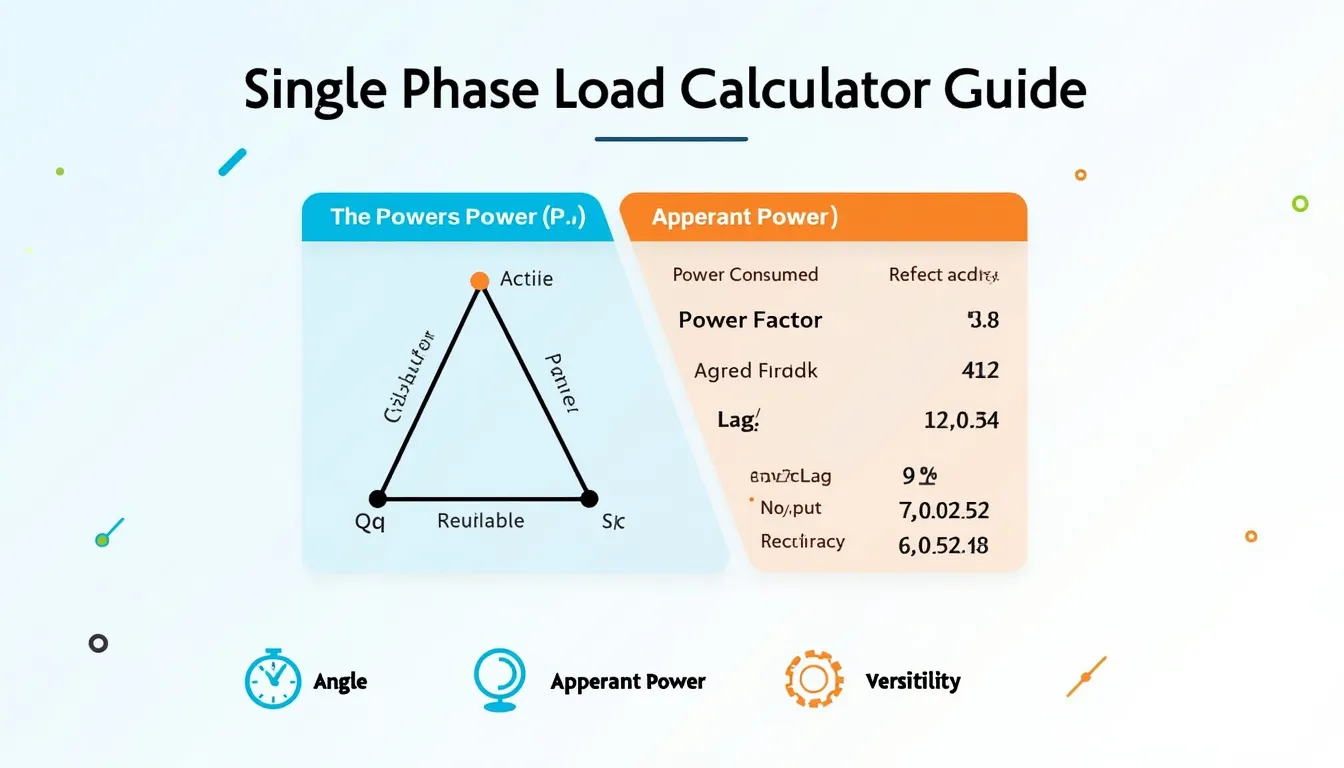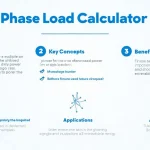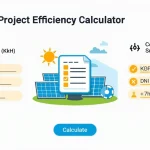Single Phase Load Calculator
Is this tool helpful?
How to Use the Single Phase Load Calculator Effectively
Using the Single Phase Load Calculator is straightforward and designed to provide accurate insights into your electrical system’s performance. Follow these simple steps to get reliable results:
- Enter the Power Consumed in kilowatts (kW). For example, try 12.5 kW or 7.3 kW.
- Input the Power Factor, which is a decimal between 0 and 1 that represents the efficiency of the system. Sample inputs could be 0.75 or 0.95.
- Select Lead or Lag according to your system’s phase relationship. Choose Lead if the current leads the voltage (capacitive loads), or Lag if the current lags behind the voltage (inductive loads).
- Click the Calculate button to view your results instantly.
After submission, the calculator presents:
- Phase Angle in radians and degrees, revealing the phase displacement between voltage and current.
- Apparent Power (S) measured in Volt-Amperes (VA), representing the total power flowing in the circuit.
- Reactive Power (Q) given in Volt-Amperes Reactive (VAR), which indicates the non-working power exchanged due to reactive components.
Introduction to the Single Phase Load Calculator
The Single Phase Load Calculator is an essential tool designed to simplify the analysis of single-phase electrical systems. Whether you’re an electrical engineer, technician, or student, this interactive calculator helps determine critical electrical parameters accurately and efficiently.
Its purpose is to assist users in optimizing power usage, improving system efficiency, and planning equipment sizing with ease. By accurately calculating power factor, reactive power, and apparent power, the tool helps reduce energy costs and improve overall electrical system performance.
Key benefits of using this calculator include:
- Fast and accurate single-phase power consumption analysis
- Enhanced understanding of power factor and its effects on loads
- Simplified system design and troubleshooting
- Support for power factor correction and energy efficiency initiatives
Understanding the Core Electrical Calculations
Power Triangle Fundamentals
At the heart of this calculator lies the power triangle, a vital concept illustrating the relationship between different power components in an AC circuit:
$$ S^2 = P^2 + Q^2 $$Where:
- S = Apparent Power (VA)
- P = Active Power or Real Power (Watts)
- Q = Reactive Power (VAR)
The Power Factor (PF) is defined as the ratio of active power to apparent power:
$$ PF = \frac{P}{S} = \cos \theta $$Where θ is the phase angle between voltage and current.
Key Formulas Used by the Calculator
Apparent Power Calculation:
$$ S = \frac{P}{PF} $$Reactive Power Calculation:
$$ Q = S \sin \theta $$These formulas help determine how power is distributed in your system and highlight any inefficiencies.
Practical Example Calculations
Example 1: Power Factor Correction
- Power Consumed: 9 kW
- Power Factor: 0.65 (lagging)
- Lead/Lag: Lag
- Calculated Phase Angle: -0.8660 rad / -49.59°
- Apparent Power: 13.85 kVA
- Reactive Power: 12.11 kVAR
This indicates that approximately 12.11 kVAR of capacitive reactive power is needed to improve power factor and system efficiency.
Example 2: System Capacity Estimation
- Power Consumed: 20 kW
- Power Factor: 0.85 (leading)
- Lead/Lag: Lead
- Calculated Phase Angle: 0.5548 rad / 31.77°
- Apparent Power: 23.53 kVA
- Reactive Power: -12.31 kVAR
Use this data to select properly rated transformers, breakers, and conductors to ensure safe and efficient operation.
Benefits of Using the Single Phase Load Calculator for Electrical Analysis
- Time Efficiency: Performs complex load calculations instantly, saving valuable engineering time.
- Enhanced Accuracy: Reduces human errors from manual calculations and improves reliability.
- System Optimization: Identifies power factor issues to optimize energy consumption and costs.
- Educational Value: Deepens understanding of electrical parameters, aiding students and professionals alike.
- Equipment Sizing: Supports precise sizing of electrical components to improve system safety and longevity.
- Troubleshooting Assistance: Helps diagnose issues related to power quality and reactive power loads.
Common Applications of the Single Phase Load Calculator
1. Residential Electrical System Design
Contractors and engineers can use the calculator to ensure residential wiring, panels, and breakers are properly rated for the household’s power consumption and reactive power needs, maintaining safety and efficiency.
2. Small Industrial and Commercial Settings
This tool assists in sizing motors, lighting, and HVAC equipment accurately while addressing power factor correction to reduce energy bills and avoid penalties.
3. Renewable Energy Installation Planning
Installers can assess load profiles and power factor characteristics for single-phase inverter systems to guarantee optimized performance of solar and wind energy setups.
4. Educational and Training Purposes
Teachers and trainers can demonstrate key electrical concepts by experimenting with different values and understanding their impact on real-world power systems.
Frequently Asked Questions (FAQ)
What is the significance of leading versus lagging power factor?
A leading power factor indicates that the current waveform leads the voltage, typically due to capacitive loads, while a lagging power factor means the current lags the voltage, often caused by inductive loads like motors and transformers. Correctly specifying this helps the calculator provide accurate reactive power measurements.
Why is power factor important in electrical systems?
Power factor affects how efficiently electrical power is used. A low power factor results in higher current draw for the same output, causing increased energy losses, overheating of equipment, and potentially higher utility charges.
How can the Single Phase Load Calculator assist in power factor correction?
By calculating the reactive power, this tool shows how much compensation is needed—often through capacitor banks or reactors—to optimize the power factor, leading to reduced losses and improved efficiency.
Is this calculator suitable for three-phase systems?
No, the Single Phase Load Calculator is designed specifically for single-phase load analysis. For three-phase systems, specialized calculators that consider phase displacement between three lines should be used instead.
How reliable are the results from this calculator?
The calculator applies standard electrical engineering formulas and depends on the accuracy of your input data. While it provides reliable estimates, always validate critical calculations with professional standards and consult qualified engineers when planning critical installations or making major decisions.
Conclusion: Streamline Your Electrical System Analysis with the Single Phase Load Calculator
The Single Phase Load Calculator is an indispensable tool for anyone involved in electrical system design, maintenance, or education. It simplifies complex calculations related to power factor, reactive power, and apparent power, empowering users to make informed decisions that improve system efficiency and performance.
Whether you are sizing components, planning power factor correction, or learning about electrical load behavior, this calculator equips you with fast, accurate, and insightful electrical analysis right from your browser.
Experience improved energy management, optimized equipment sizing, and deeper understanding of single-phase electrical systems today by incorporating this powerful tool into your workflow.
Important Disclaimer
The calculations, results, and content provided by our tools are not guaranteed to be accurate, complete, or reliable. Users are responsible for verifying and interpreting the results. Our content and tools may contain errors, biases, or inconsistencies. Do not enter personal data, sensitive information, or personally identifiable information in our web forms or tools. Such data entry violates our terms of service and may result in unauthorized disclosure to third parties. We reserve the right to save inputs and outputs from our tools for the purposes of error debugging, bias identification, and performance improvement. External companies providing AI models used in our tools may also save and process data in accordance with their own policies. By using our tools, you consent to this data collection and processing. We reserve the right to limit the usage of our tools based on current usability factors.







